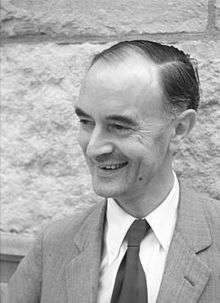Christopher Kelk Ingold
Sir Christopher Kelk Ingold BEM FRS[1] (28 October 1893 – 8 December 1970) was a British chemist based in Leeds and London. His groundbreaking work in the 1920s and 1930s on reaction mechanisms and the electronic structure of organic compounds was responsible for the introduction into mainstream chemistry of concepts such as nucleophile, electrophile, inductive and resonance effects, and such descriptors as SN1, SN2, E1, and E2. He also was a co-author of the Cahn–Ingold–Prelog priority rules. Ingold is regarded as one of the chief pioneers of physical organic chemistry.[3][4][5]
Sir Christopher Kelk Ingold | |
|---|---|
 Ingold, as photographed in Michigan State University. | |
| Born | 28 October 1893 London, United Kingdom |
| Died | 8 December 1970 (aged 77) Edgware, London |
| Nationality | British |
| Citizenship | British English |
| Alma mater | Hartley University College (now University of Southampton) Imperial College London |
| Known for | Organic reaction mechanisms Cahn–Ingold–Prelog rules Hughes–Ingold rules Thorpe-Ingold effect |
| Awards |
|
| Scientific career | |
| Fields | Chemistry |
| Institutions | Imperial College London University of Leeds University College London |
| Thesis | Formation and stability of carbon rings (1921) |
| Academic advisors | Jocelyn Field Thorpe |
| Doctoral students | Ronald Gillespie Ronald Sydney Nyholm[2] |
| Signature | |
Biography

Born in London to a silk merchant who died of tuberculosis when Ingold was five years old,[1] Ingold began his scientific studies at Hartley University College at Southampton (now Southampton University) taking an external BSc in 1913 with the University of London. He then joined the laboratory of Jocelyn Field Thorpe at Imperial College, London, with a brief hiatus from 1918-1920 during which he conducted research into chemical warfare and the manufacture of poison gas with Cassel Chemical at Glasgow.[6] He earned an MSc degree from the University of London, and returned to Imperial College in 1920 for work with Thorpe.[7] He was awarded a PhD in 1918 and a DSc in 1921.
Ingold married Dr. Hilda Usherwood, a fellow chemist with whom he collaborated, in 1923. They had two daughters and a son, the chemist Keith Ingold.[8]
In 1924, Ingold moved to the University of Leeds, where he spent six years as professor of organic chemistry. He returned to London in 1930, and served for 24 years as head of the chemistry department at University College London, from 1937 until his retirement in 1961.
During his study of alkyl halides, Ingold found evidence for two possible reaction mechanisms for nucleophilic substitution reactions. He found that tertiary alkyl halides underwent a two-step mechanism (SN1) while primary and secondary[9] alkyl halides underwent a one-step mechanism (SN2). This conclusion was based on the finding that reactions of tertiary alkyl halides with nucleophiles were dependent on the concentration of the alkyl halide only. Meanwhile, he discovered that primary and secondary alkyl halides, when reacting with nucleophiles, depend on both the concentration of the alkyl halide and the concentration of the nucleophile.
Starting around 1926, Ingold and Robert Robinson carried out a heated debate on the electronic theoretical approaches to organic reaction mechanisms. See, for example, the summary by Saltzman.[10]
In 1920, Ingold was awarded the British Empire Medal (BEM) for his wartime research involving "great courage in carrying out work in a poisonous atmosphere, and risking his life on several occasions in preventing serious accidents,"[11] though he subsequently never discussed the award or this period in his life.[6] He received the Longstaff Medal of the Royal Society of Chemistry in 1951, the Royal Medal of the Royal Society in 1952, and was knighted in 1958. The chemistry department of University College London is now housed in the Sir Christopher Ingold building, opened in 1969.
Ingold authored and co-authored 443 papers.[12]
References
- Shoppee, C. W. (1972). "Christopher Kelk Ingold. 1893-1970". Biographical Memoirs of Fellows of the Royal Society. 18: 348–411. doi:10.1098/rsbm.1972.0012.
- Livingstone, Stanley E. "Nyholm, Sir Ronald Sydney (1917–1971)". Australian Dictionary of Biography.
- Saltzman, M. D. (1986). "The development of physical organic chemistry in the United States and the United Kingdom: 1919–1939, parallels and contrasts". Journal of Chemical Education. 63 (7): 588. doi:10.1021/ed063p588.(subscription required)
- Ingold, C. K. (1953). Structure and Mechanism in Organic Chemistry. Ithaca, New York: Cornell University Press. ISBN 0-8014-0499-1.
- Ingold, Christopher K. (1934). "Principles of an Electronic Theory of Organic Reactions". Chemical Reviews. 15: 238–274. doi:10.1021/cr60051a003.
- Ridd, John (December 2008). "Historical Profile - Organic Pioneer" (PDF). Chemistry World: 50–53.
- Ingold, C. K. (1941). "Jocelyn Field Thorpe. 1872–1939". Obituary Notices of Fellows of the Royal Society. 3 (10): 530–544. doi:10.1098/rsbm.1941.0020. JSTOR 769165.
- Nye, Mary Jo (1994). From Chemical Philosophy to Theoretical Chemistry. University of California Press. pp. 197–198. ISBN 978-0-520-08210-6.
- Absence of SN1 Involvement in the Solvolysis of Secondary Alkyl Compounds, T. J. Murphy, J. Chem. Educ.; 2009; 86(4) pp 519–24; (Article) doi: 10.1021/ed041p678
- Saltzman, M. D. (1980). "The Robinson-Ingold controversy: Precedence in the electronic theory of organic reactions". Journal of Chemical Education. 57 (7): 484. doi:10.1021/ed057p484.
- "No. 31967". The London Gazette (Supplement). 6 July 1920. p. 7308.
- Saltzman, Martin D. (1996). "C. K. Ingold's Development of the Concept of Mesomerism" (PDF). Bulletin for the History of Chemistry. 19: 25–32.
Further reading
Dr. Malmberg's class: K.P.
- Leffek, Kenneth T. (1996). Sir Christopher Ingold: A Major Prophet of Organic Chemistry. Nova Lion Press. ISBN 0-9680674-0-9.
- Ridd, John (December 2008). "Organic Pioneer" (PDF). Chemistry World. 5 (12): 50–53.
External links
- Biography at Michigan State University
- Biography and history at University College London.